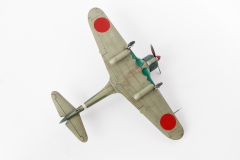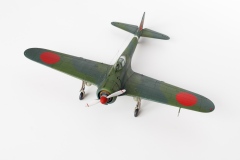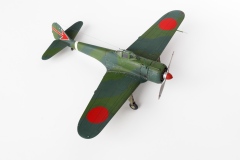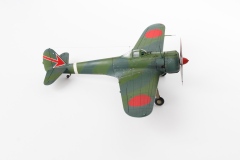Nakajima Ki-43-I Hayabusa (Oscar) 1/72 FineMolds
I recently finished a model of the Nakajima Ki-43, one of the most numerous Japanese WW2 fighters, a land-based contemporary of the more famous Mitsubishi A6M Zero.
A year or two ago, I got this obscure kit as a gift from my friend (thanks, Rob!). It is a new tool made in 2019 by FineMolds, but as far as I know, for some weird reason, the manufacturer only ever released it as a single boxing with a single decal variant… from some anime about dogfighting schoolgirls, or whatever. For this reason, I guess not many people outside of Japan even know this kit exists.
Therefore, I had to search for a paint variant myself. I wanted a model without complicated markings (so I could use my own airbrush masks), not boring (i.e. just silver or mono green) but with not too difficult camouflage either (like, small-scale mottle on a metal surface). In the end, I found this machine of the 64th Sentai stationed in Malaya in 1942. By the way, only when writing this article I realized that in the photo, there is no antenna mast! Let’s say it was deleted by a censor, ok? 😉
As for the kit, it has all you could expect from a most recent new tool – perfect fit of the main parts, superb details. Everything is very delicate – even too delicate in some places. The bottom side of the wing was cracked in two places and required careful gluing and sanding to keep the rivets and panel lines intact. The tail wheel shaft seems to collapse under the own weight of the model. But then again, the real Ki-43 was flimsy, too, so I guess it’s ok 😀
The panel lines are deep enough (in contrast to most Japanese kits I have seen) and the surface is riveted all over. The rivets are not too prominent, and look fine on a camouflaged surface, on bare metal it might be a different story, though.
Attaching the small parts was a bit annoying because there are too big tolerances on the mating surfaces, so everything is wobbly – I guess if you apply a really thick layer of paint, this might become an advantage. 🙂
Everything is out-of-the-box, except for the drop tanks, which I 3D modeled and printed myself. They are available here on Printables.com, together with the airbrush masks for the insignia. There are four holes for the oblique braces in each tank, however, I was too lazy to add them myself.
The most peculiar feature of the kit is the canopy framing. The separate frames made from opaque plastic have to be glued to the transparent parts. They fit well, but attaching them cleanly was a challenge nonetheless. I cut the vertical frames too short (it was hard to discern where the sprue ends and the part begins) and as a result, they couldn’t reach the lower edge frame. As you can see in the photo, I had to carefully fill and sand the gaps, which defeated the main advantage of having separate frames, i.e. the absence of masking. 🙁
As for the colors: at first, I thought the wavy camo is supposed to be green/reddish brown. Because I have almost Zero-knowledge (pun intended) about Japanese airplanes, I contacted Nick Millman of the Aviation of Japan blog. He gave me thorough information both about the main camouflage and also the color of all the details like the cockpit and propeller. It is so much better to contact a single expert instead of randomly carpet-bombing Facebook groups with questions (that is, if you can find such a helpful guy like Nick).

According to this reference chip, I think I got the darker blue-green spot on, the lighter green is probably far too warm, but I’ll just have to live with that. I already resprayed the camo once, because in the first iteration, the green resembled olive drab, and as a result, the whole camo looked like the British Temperate Sea Scheme. 😀

By the way, I am not sure about the cowling camouflage demarcation line – I made the darker colors envelop the whole cowling except for the chin cooler, on the photo above (of a different machine, but still), you can see that the whole cowling bottom is actually the underside color.
All the paints are Tamiya acrylics (except for the Gunze Supermetallic silver), but the shades are a mix of everything (I don’t remember the numbers let alone ratios).
As for the chipping, it is made with a combination of grey Vallejo paint on a thin brush and a silver pencil. I went for very light intensity (by Japanese standards) as large chipped areas, in my opinion, always look out of scale on a 1/72.
Enjoy, any comments or criticism are appreciated, as always.












Absolutely Brilliant !
Such a beautiful version of a rarely seen model …crafted to perfection by Mr. Kafka…superlative in every aspect … Realistic camouflage scheme, subtle weathering and 3D drop tanks all combine for an amazing “Oscar-san”
Banzai ! Vlad